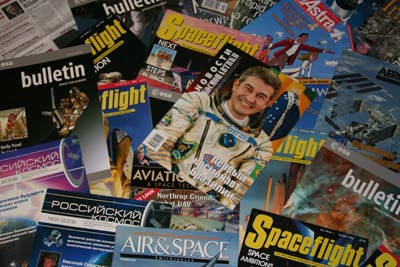A quick guide to space news publications in printby Dwayne A. Day
|
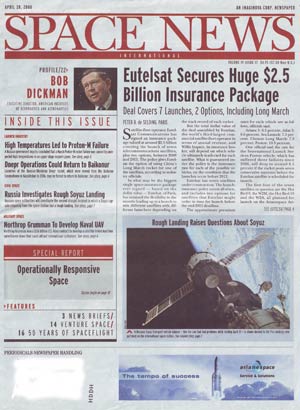 |
Space News
Weekly
Subscription: $169 a year
Okay, it is a newspaper, not a magazine, but if timely and comprehensive space news is what you want and need, then Space News is the one publication that you should subscribe to. They cover all current news aspects: American human and robotic spaceflight, international programs, military, and commercial space. They are with little doubt the best source for American military space news (although the recent departure of Colin Clark means that their scoops on the American intelligence space program will diminish). Their US coverage tends to be Washington-centric, meaning that they focus primarily on budgets and plans rather than operations; you won’t find detailed summaries of shuttle and station missions, for instance. But if you want to know what is going to happen, this is the place to look. Their foreign coverage is relatively thin (only about one article per issue), but often insightful, and still adds up to a lot of coverage over the course of a year.
Space News also offers their articles on a website available to subscribers. If this was available for free (in a slightly more user-friendly format), it would be close to being the one-stop-shopping space information website that we’d all like to see exist. But because they generate their own content, they need to generate their own revenue, and hence the subscription fee.
There are other sources with more detailed information on some of the topics covered by Space News. For instance, if you are interested in European and Russian space programs and technical details, then ESA Bulletin and Novosti Kosmonavtiki are what you want. But Space News offers the broadest overall coverage—it’s only half a mile wide, but it’s also half a mile deep.
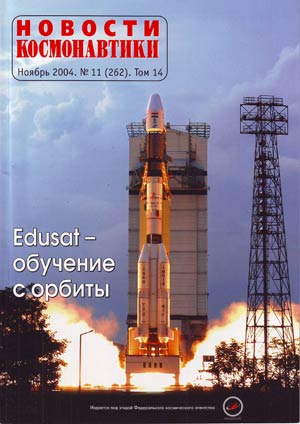 |
Novosti Kosmonavtiki (Spaceflight News)
Monthly
Subscription: $170 for U.S. residents
Main website: http://www.novosti-kosmonavtiki.ru/
This is, hands-down, the best space magazine in the world. Alas, it is in Russian and there is no English translation.
How do I know it’s the best space magazine in the world? Several colleagues who read Russian sing the magazine’s praises and have explained how NK frequently includes information that appears nowhere else—not only on Russian subjects, but also on American, European, Japanese, Latin American, and commercial space projects. But NK’s quality and breadth is also evident simply from looking at the topics the magazine covers and the illustrations that they run. The subjects cover a broad range, and NK devotes much attention to Western science and military space projects. Although they obtain some of this information from secondary sources and public websites, there is ample evidence that the magazine has reporters who not only search wide and far for original information, but are able to carefully analyze it. Furthermore, some subjects covered in NK are almost never covered anywhere else—even when they could be. For instance, Novosti Kosmonavtiki has run detailed articles on current American military plans for satellite communications that I have not seen discussed in American publications. They don’t acquire this information through espionage, they get it from surfing websites, attending conferences, and gathering data. Several years ago they even had an article on the calibration targets that the Russian military photographs from orbit to assess the quality of their reconnaissance satellites. They frequently run detailed articles on American and European robotic space science missions.
| Novosti Kosmonavtiki is hands-down, the best space magazine in the world. Alas, it is in Russian and there is no English translation. |
NK is sponsored by both the Russian space agency Roskosmos and the Russian Space Forces. Not only does this pay for their printing, but it also gives them access to senior officials who often make extremely candid comments about the current state of the Russian space program. Whereas NK will not editorially criticize the Russian space program, they do publish articles by others who do. However, there has been a notable change in some of their coverage in recent years. In the 1990s and early this decade they regularly published insightful articles about current Russian military space projects. They started shying away from those topics about three or four years ago as the journalistic environment in Russia chilled and people started going to jail for writing about military subjects (those were the lucky ones—journalists writing about corruption in Russia have frequently been killed). But NK still publishes articles on historical Soviet/Russian military space programs.
NK’s photographic reproduction and paper quality is top notch. This is a great magazine, and far better than anything produced in the United States. All we need is an English language version, or a really smart robot translator to read it to us.
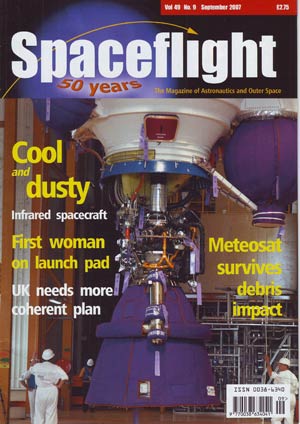 |
Spaceflight
Monthly
BIS membership (includes magazine): £53 (currently about US$104)
The oldest space publication and still a strong contender as one of the best. If you are looking for a comprehensive space news magazine in English, this is probably your best choice. Published by the British Interplanetary Society, Spaceflight covers a broad range of topics, including current human and robotic spaceflight, although its focus is more on human spaceflight. Most issues feature a detailed summary of human spaceflight operations, primarily onboard the International Space Station, and an account of completed shuttle flights. Spaceflight also usually features at least one space history article per issue, often by Joel Powell or myself. In the past, history articles by Asif Siddiqi and Timothy Varfolomeyev have provided fascinating information on the Soviet and Russian space programs unavailable anywhere else.
After a short period of poor print quality several years ago, Spaceflight’s overall printing quality has improved, although the layout tends to be relatively conservative, if not simply boring. Photo and paper quality are not as good as many other European publications, but are on par with most American magazines.
In many ways Spaceflight is the “publication of record” for space subjects. Because of its age and reputation, and because it is carried by several hundred libraries around the world (many in the United States), articles in Spaceflight tend to have a long shelf life—people look through back issues for information that they cannot easily access elsewhere. I know several space historians today who were heavily influenced by Spaceflight when they were in high school and college because it was the only available publication that covered these subjects.
Spaceflight does not pay their writers, so the writers tend to be enthusiasts. Nevertheless, these enthusiasts often tend to be incredibly knowledgeable about their subjects, and regular contributors like Philip Corneille and Neville Kidger obviously focus intently upon the subjects that they cover.
Despite the fact that I write for the magazine on a regular basis, I have my pet peeves about Spaceflight. One complaint is the amateurish articles along the lines of “how I met an astronaut during his visit to Nottingham.” Admittedly, the magazine’s base (indeed, the BIS membership) consists of space enthusiasts, so this is not surprising. Probably a bigger problem is the magazine’s occasional blunder, like publishing articles based upon extremely dubious research.
| I know several space historians today who were heavily influenced by Spaceflight when they were in high school and college because it was the only available publication that covered these subjects. |
For Americans there are several drawbacks to Spaceflight, primarily its high cost and the slow delivery time from England, each issue arriving in the US about a month after it has reached readers in Great Britain and Europe, and 6–8 weeks after the news events have actually happened. This means that many of the shorter articles (like the blurbs on the latest space developments) are badly outdated by the time American readers see them. In many ways this is the classic dilemma of the modern publishing age—in 1988 Spaceflight was the primary way for space enthusiasts to get information about space news that was not available any other way, but now that is all on the Internet almost immediately. As a result, Spaceflight’s primary value remains its more in-depth articles and its histories, as well as its photographs.
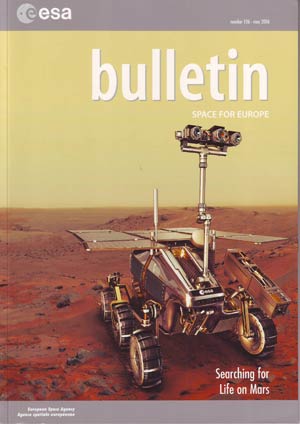 |
ESA Bulletin
Bi-monthly
Subscription: Free
This is a high-quality journal/magazine produced by the European Space Agency that everybody should subscribe to. After all, it’s free. Each issue features a handful of articles covering current ESA space missions, including both human and robotic projects. Some of the articles are devoted to projects in development whereas others discuss operations and scientific discoveries made by robotic spacecraft. The issues also feature a “Programmes in Progress” section providing an overall summary of all of ESA’s programs in flight or in development, a great resource on everything that ESA is doing. The paper and photo reproduction quality is excellent and the layout is acceptable, if a little too European bureaucratic at times.
This is the kind of publication that NASA should produce as an overview to its programs. NASA already produces some rather dull in-house newsletters and magazines, but it would be wonderful if the biggest space agency in the world would take a clue from ESA and copy the Bulletin to tell the world what the agency does all in one glossy, high-quality printed publication.
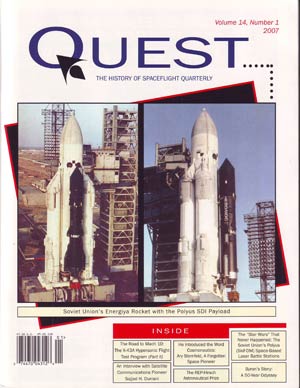 |
Quest
Quarterly
Subscription: $29.95
A space history journal published by the University of North Dakota. Although its primary focus is American spaceflight, both human and robotic, the journal has also published excellent articles on European and Russian spaceflight. Quest has published some fascinating history articles on a wide range of subjects not covered elsewhere.
Quest has its highs and lows, and I find it to be the most disappointing magazine on this list because it should be better than it is. In my opinion the quality has improved in the last few years after dipping somewhat. Unfortunately, Quest can still be schizophrenic and occasionally publish a great article alongside something truly bad. Quest’s weaknesses include its small circulation base and lack of visibility (it was briefly available in bookstores). In addition, it is also only carried by about a dozen libraries worldwide, making it very difficult to find an issue just to look at it, and meaning that its influence is not going to extend very far beyond its immediate subscription base. Quest also suffers from boring covers, uninspiring graphic design/layout (although, admittedly, it is a journal and not a magazine), extremely bad photo quality (lots of pixilated images reproduced at small sizes), and lack of color photographs. While all of this seems pretty negative, I’d simply reiterate that on occasion they have published some really great historical material.
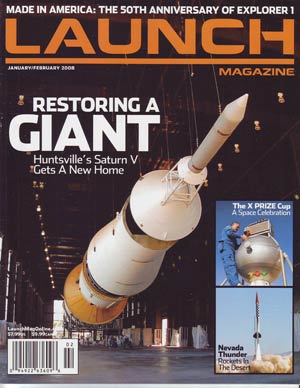 |
Launch
Bi-monthly
Subscription: $29.95
A gorgeous newcomer to the space publications scene. This glossy magazine can be found in most large bookstores. It has beautiful covers and slick layout. It just looks good. Their market is spaceflight enthusiasts, “future space tourists,” and amateur rocketry enthusiasts. The amateur rocketry tends to dominate the magazine, but each issue usually contains at least one article on spaceflight (with an emphasis on rockets, as opposed to spacecraft) one on space tourism, and one on space history. The target demographic is clearly younger than for many other space publications, and the articles are not as long or detailed as those in magazines like Spaceflight, Novosti, or Ad Astra.
It is always exciting when a new and highly professional space publication debuts, but the high quality of this magazine undoubtedly means high costs, and I’m skeptical that they will be able to find a market to sustain them. In 1988 the magazine Final Frontier started publishing and it managed to last for ten years, but the quality steadily diminished after the first few years. Hopefully, Launch will last at least that long, without losing quality. Have I mentioned how good it looks?
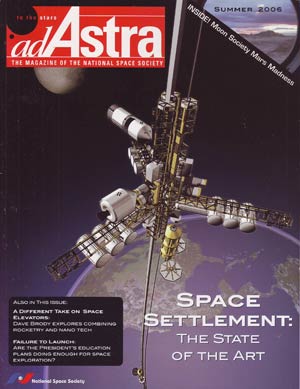 |
Ad Astra
Quarterly
NSS Membership: starts at $20
The publication of the National Space Society (NSS), Ad Astra is devoted to the topics that NSS’s membership is interested in, primarily space development and settlement. Thus, you will not find many articles about current robotic or human space missions, but you will find articles about lunar colonies, Mars expeditions, space colonies, and solar power satellites.
| It is always exciting when a new and highly professional space publication debuts, but the high quality of Launch undoubtedly means high costs, and I’m skeptical that they will be able to find a market to sustain them. |
Ad Astra’s predecessor, Space World, was one of my early introductions to the space field, and my first paying article was to Ad Astra. That aside, I’ve had mixed feelings about the magazine over its many years of existence, which probably has more to do with me than with its overall quality. I’ve rarely found much inside that I’ve wanted to read—Ad Astra/Space World have been publishing articles on lunar bases and solar power satellites for decades now and little seems to have changed. One could argue that it’s not the magazine’s fault, but the fault of the rest of the world for not living up to their expectations. But we’re no closer to an O’Neill Colony now than the first time they put it on the cover, and thus it seems to me that the magazine is stuck in a perpetual time loop. I’ve also long found the magazine’s look to be off-putting, with text that lacks sufficient margins and a rather stodgy layout. But those are just personal opinions, and I’ve heard rumors that a makeover may be in the works and Ad Astra will be produced by the same skilled graphics team that produces Launch.
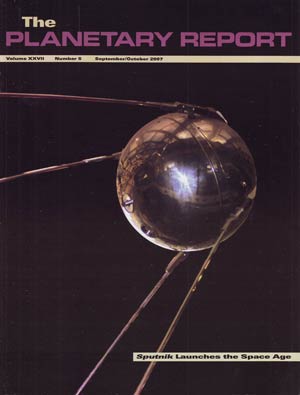 |
The Planetary Report
Bi-monthly
Planetary Society Membership: starts at $30
The magazine of The Planetary Society. This magazine primarily focuses upon robotic spacecraft for exploring the solar system. The launch industry, military space, communications satellites, and even astronomy spacecraft are never even mentioned. The primary purpose of the magazine is to keep members of the Society apprised of its activities and upcoming events. This probably makes TPR more useful to people who live in southern California and can attend their events, but I’m willing to concede that it serves more of a newsletter function than a news function.
Despite my enthusiasm for this publication’s focus area, The Planetary Report has always seemed a bit stodgy. The issues are quite thin, for starters. But another problem has been that the stories never seem timely. They summarize subjects that have already appeared in other publications or on the web months before, and offer nothing more in terms of depth than what I’ve already found elsewhere.
